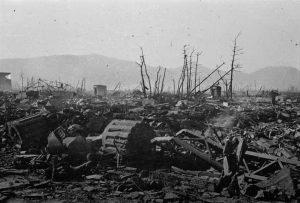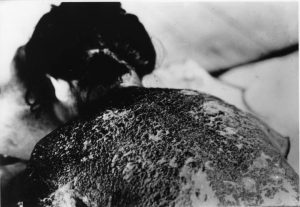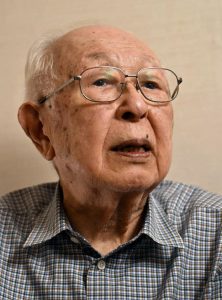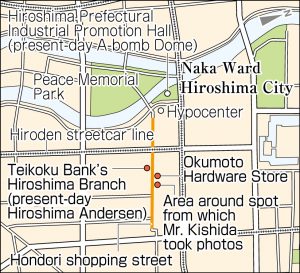Documenting Hiroshima of 1945: August 7, unforgettable tragedy in vicinity of smoldering hypocenter
Aug. 7, 2024
“Still sea of embers under debris”
by Kyosuke Mizukawa, Senior Staff Writer
On the morning of August 7, 1945, the day after the atomic bombing, Hiroshi Okumoto, 15 at the time, who is now 94 and a resident of Hiroshima’s Naka Ward, headed to Hondori shopping street, in the central area of Hiroshima. The street, which had been made up of around 160 shops before the bombing, was burned to the ground. The Okumoto Hardware Store, where Mr. Okumoto had lived with his other seven family members until the day prior to the bombing, was also turned into rubble at a location around 420 meters southeast of the hypocenter.
Mr. Okumoto said, “When I tried to step onto the site of my home, there was still a sea of embers under the debris… When I took a look at a nearby water tank used for fire prevention, composed of a big sake barrel buried beneath the ground, I found the body of someone who had fallen into the tank and died.”
“Other family members somewhere”
At the time, Mr. Okumoto, a third-year student at Shudo Junior High School, experienced the atomic bombing at the location where he had been mobilized to work, around 4.1 kilometers from the hypocenter. He gave up his idea of entering the central part of the city, which was aflame, and spent the night in an air-raid shelter at a relative’s home in the city. He tore a sheet of paper from his pocketbook, wrote “Hiroshi, Alive and Well” on the paper, and placed it on a collapsed steel electric pole near the ruins of home with a stone set on top to keep it in place. In the belief that his other family members “must have fled somewhere,” he wanted to convey to them the message that he was safe.
That day, Mitsugi Kishida, who died in 1988 at the age of 72 and at the time was serving as a member of the news team of the Imperial Japanese Army’s Chugoku District Military Headquarters situated inside Hiroshima Castle, held a camera at hand as he entered Hondori shopping street, where his home-cum-photo studio, then closed, had stood. On the previous day, after the atomic bombing, Mr. Kishida had returned to the city from the northern part of Hiroshima Prefecture, where he had been visiting for business. However, according to a letter Mr. Kishida wrote while alive, he did not take any photographs that day. “People groaning, suffering in pain, and begging for help… Instead of taking photos, the only thing I could do was help the victims drink water.”
On August 7, he determined that he “must keep a record of the unprecedented devastation for future generations.” He snapped his camera’s shutter from the vicinity of his home, which was located around 480 meters from the hypocenter. The embers of fires were still smoldering all around him.
One of his photos, taken facing west, captured the ruins of the Okumoto Hardware Store and the collapsed electric pole. Mr. Okumoto’s regret is also reflected in the photo. “Later, when the ground surface appeared again after the debris of my family’s shop was exposed to rain and wind for many days, there was a small set of bones there. I thought it must have been Taeko’s,” said Mr. Okumoto. She was his youngest sister, who was four at the time. Ultimately, Mr. Okumoto lost his parents and four siblings in the atomic bombing.
Photographer also victim
A photo taken on Ninoshima Island on August 7, a remote island off the coast of Hiroshima Bay where a continuous stream of wounded victims had been taken, remains. Masami Onuka, 23 at the time, who died in 2011 at the age of 89, was a member of the photography corps of the Japanese Imperial Army Shipping Command, located in the area of Ujina-machi (in Hiroshima’s present-day Minami Ward). Mr. Onuka was ordered by a military physician to take photos of a woman with a severely burned back as well as of a man with burns over his entire body. He later shared his feelings at that time.
“Despite being an order from above, I thought it was so cruel,” said Mr. Onuka in a testimony recorded by the Hiroshima Peace Culture Foundation in 1992. “If I had been a victim in one of my photographs, I would have thought it unacceptable to show me in such misery.”
As a result of his agonizing job of photography, the images of people the day after they had been exposed to intense thermal rays were precisely recorded. Mr. Onuka himself experienced the atomic bombing in the front yard of the Army headquarters, which was located around 4.6 kilometers from the hypocenter. He searched for his mother, Makino, 60 at the time, who was living in the area of Minami-machi (in Hiroshima’s present-day Minami Ward), but was unable to find even her remains. The photographer was also a victim of the atomic bombing.
(Originally published on August 7, 2024)












